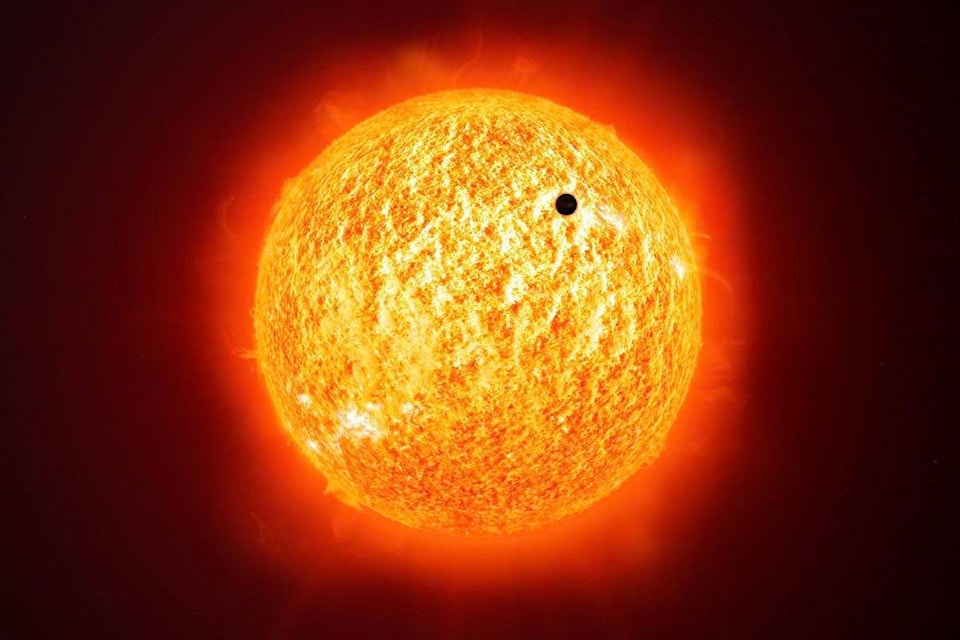On Nov. 11, Mercury, the closest known planet to the sun, will cross the solar disc.
Observers will see a small, round disc move slowly across the sun from one side to the other. If you don’t see this one, you will have to wait until 2032 before it happens again. However, if you are not an experienced solar observer, with the right hardware, trying to observe this event can be extremely dangerous, with a serious risk of permanent eye damage. Looking at the sun through a telescope or binoculars not fitted with filters made explicitly for this purpose by a reputable telescope manufacturer can be deadly. It is even risky to stare at the sun with naked eyes.
Since Mercury and Venus orbit between us and the sun, they are the only planets we will ever see as small, round silhouettes crossing the solar disc. All the other planets pass behind the sun. In the past astronomers tried hard to observe transits of Mercury and especially Venus, because carefully timed observations from precisely located positions on the Earth made it possible to establish the actual scale of the solar system. Most other measurements give us results like the “this one is seven times further away than that one” — measurements we were otherwise stuck with.
Mercury takes about 88 days and Venus 225 days to orbit the sun. Since the Earth takes 365.25 days to complete each circuit around the sun, and all the planets orbit the sun in the same direction, Mercury and Venus will overtake us on the inside lane every 116 and 584 days respectively. We would expect to see them against the solar disc as they do so. Unfortunately, their orbits and also the orbit of the Earth are slightly inclined, so usually, when they are overtaking us, they will lie above or below the solar disc in the sky, and invisible in the glare.
For us to see them crossing the solar disc the sun, planet and Earth need to be precisely in line. Since Mercury lies closer to the sun than Venus, we see it transit the disc more often. On average, we see transits of Mercury every few years; because Mercury orbits close to the sun, the transit is visible from a large part of the Earth’s surface. Transits of Venus are much rarer; they occur in pairs a few years apart with more than a century separating each pair. Astronomers have been sent all over the world to observe transits of Venus. In the 18th Century, one was sent to an island in the Pacific to record a transit of Venus and was clouded out on the big day, so his bosses told him to stay there for almost a decade to see the next one. The locals told him that the chosen island was known for its bad weather and that a nearby island would be a much better bet. He made the mistake of writing to his bosses about his move and was ordered to return to where they had told him to go, and he was clouded out; the recommended island had clear weather.
At least part of this transit will be visible from most locations across Canada. Here are the start and end times for a selection of western cities across Canada, in Local Standard Time, as obtained from the Observer’s Handbook of the Royal Astronomical Society of Canada, on Nov. 11: Winnipeg, Man. (sunrise to 12:04), Regina, Sask. (sunrise to 12:04), Edmonton, Alta (sunrise to 11:04), Vancouver, B.C. (sunrise to 10:04).
The safest way to observe the event is with astronomers from your local astronomy club or Centre of the Royal Astronomical Society of Canada. You can find contact information for your local RASC centre at https://www.rasc.ca/centres.
Jupiter and Saturn lie low in the southwest after dark. The moon will be full on Nov. 12. Mars lies very low in the east before dawn.
Ken Tapping is an astronomer with the Dominion Radio Astrophysical Observatory near Penticton. Email: ken.tapping@nrc-cnrc.gc.ca
